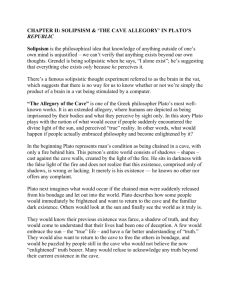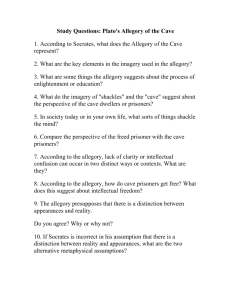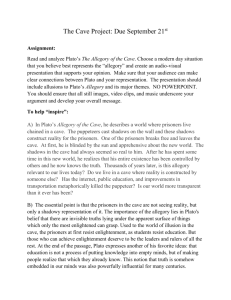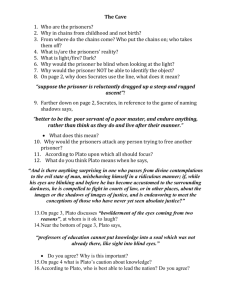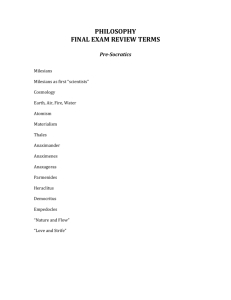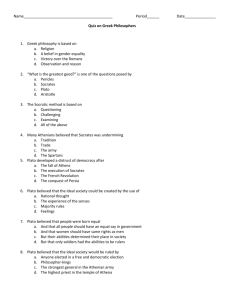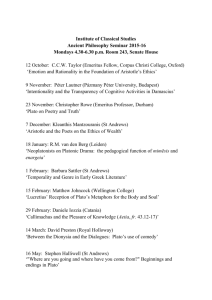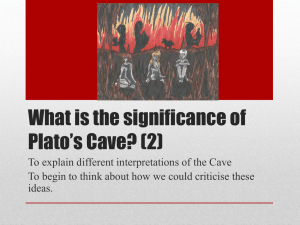Plato`s Allegory of a Cave
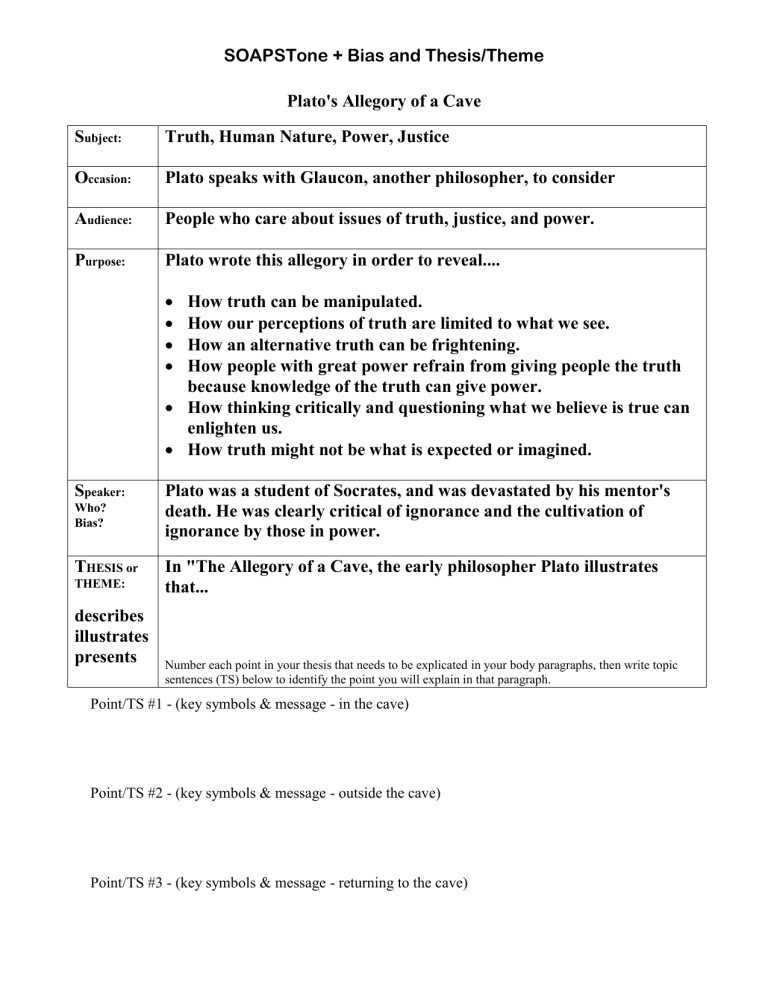
SOAPSTone + Bias and Thesis/Theme
Plato's Allegory of a Cave
S ubject:
O ccasion:
A udience:
P urpose:
Truth, Human Nature, Power, Justice
Plato speaks with Glaucon, another philosopher, to consider
People who care about issues of truth, justice, and power.
S
Who?
Bias?
T peaker:
HESIS or
THEME: describes illustrates presents
Plato wrote this allegory in order to reveal....
How truth can be manipulated.
How our perceptions of truth are limited to what we see.
How an alternative truth can be frightening.
How people with great power refrain from giving people the truth because knowledge of the truth can give power.
How thinking critically and questioning what we believe is true can enlighten us.
How truth might not be what is expected or imagined.
Plato was a student of Socrates, and was devastated by his mentor's death. He was clearly critical of ignorance and the cultivation of ignorance by those in power.
In "The Allegory of a Cave, the early philosopher Plato illustrates that...
Number each point in your thesis that needs to be explicated in your body paragraphs, then write topic sentences (TS) below to identify the point you will explain in that paragraph.
Point/TS #1 - (key symbols & message - in the cave)
Point/TS #2 - (key symbols & message - outside the cave)
Point/TS #3 - (key symbols & message - returning to the cave)
SOAPSTone + Bias and Thesis/Theme
Rhetorical Precis (Introduction)
1.
Name of author, [optional: a phrase describing author], genre and title of work date in parentheses (additional publishing information in parentheses or note); a rhetorically accurate verb (such as “assert,” “argue,”
“suggest,” “imply,” “claim,” etc.); and a THAT clause containing the major assertion (thesis statement) of the work.
2.
An explanation of how the author develops and/or supports the thesis, usually in chronological order.
3.
A statement of the author’s apparent purpose followed by an “in order to” phrase.
4.
A description of the intended audience and/or the relationship the author establishes with the audience.
SOAPSTone + Bias and Thesis/Theme
What do you need to know before writing this essay?
what the rhetorical techniques are
a tone to lure the audience
no bias regarding the allegory
a strong thesis
how to describe persuasively
how to approach argument in the correct form
identify the different appeals in the allegory and which ones are used
understand the goal
understand Plato's purpose
identify Plato's thesis
In "The Allegory of a Cave, the early philosopher Plato illustrates that truth is all too elusive, especially when those in power intentionally mislead their people so as to take advantage of their ignorance.
In his allegory, Plato combines symbolism, logos and ethos to describe a dark cavern where prisoners are led to believe that the shadows they see represent all of reality until one who has seen the world outside unsuccessfully tries to convince them otherwise. Plato juxtaposes these two different perceptions of the world in order to demonstrate people's gullible nature and the need for an enlightened and selfless leader to guide everyone towards a more just society.
This dialogue between Socrates and his student is intended for those, like
Socrates, who recognize the need to question commonly held beliefs and the authorities who espouse those beliefs, for it is only through questioning and an open-minded search for truth that we can recognize and overcome attempts to manipulate our perceptions.
Inside the cave, Plato uses the light from a fire, marionettes, and shadows to symbolize the reality that is manipulated by puppeteers.
Shadows represent the truth the prisoners believe
quote passages (paraphrase parts)
explain your interpretation of the quotes
explain how the shadows relate to other symbols in this section
connect your interpretation to the thesis
SOAPSTone + Bias and Thesis/Theme
SOAPSTone + Bias and Thesis/Theme
Write a well-constructed essay that analyzes how Plato uses allegory as a rhetorical device to express his philosophy about truth, justice, and/or power in "Allegory of the Cave."
Your introduction should follow the format of a rhetorical precis
(see the handout that was distributed in class last week) and include your interpretation or definition of Plato's philosophy. In your body paragraphs, be sure to explain how evidence from the text supports your interpretation.
Turn this prompt into 2 questions (Thesis Generator)
- What is Plato's philosophy about truth, justice, or power?
- How does Plato use allegory as a rhetorical device to express this philosophy?

